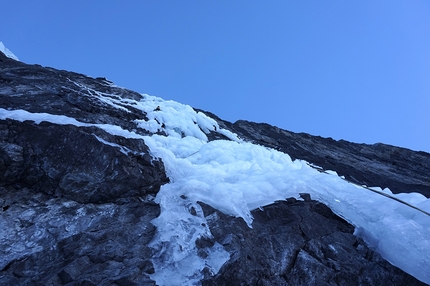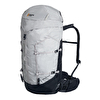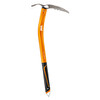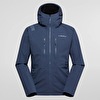Pleishornwasserfall, new ice climb on Ortler North Face

 1 / 8
1 / 8 Daniel Ladurner, Johannes Lemayer
Daniel Ladurner, Johannes Lemayer
South Tyrolean alpinists Daniel Ladurner and Johannes Lemayer have plucked a plum line on the NE Face of Ortler with their first ascent of Pleishornwasserfall. Located directly beneath the seracs on the mountain’s North Face and close to the minor summit Pleishorn, the line rarely comes into condition. According to the first ascentionists, possibly the reason why it has now formed is that the seracs the usually loom above the face broke off a while ago.
Lemayer first noticed that ice had formed two months ago. On 8 December he reccied the approach from Trafoi, and returned two days later with Herbert Plattner. The two climbed three pitches to half-height, but were forced to retreat due to lack of time. On 13 December Lemayer tackled the 3-hour, 1500m elevation gain approach once again, this time with Ladurner and completed the line. This tackles brittle rock and the tenuous hanging drip and is described as "a very serious outing."
"The route is located beneath the seracs" explained Ladurner "but actually when we climbed it these didn’t really pose much of a danger. At present they don’t overhang above the face, so from that point of view it was alright. It was the brittle Ortler rock and the ice which was really worrying and I’ve never seen anything quite like it: instead of dripping down from the top, the ice jutted straight out of the cracks, forming thin drips topped every 40m by huge ice mushrooms. The quality of the ice was bizzarre and we had to drive most ice screws upwards."
The duo reached the previous highpoint by climbing two long pitches instead of the original three. They were now faced with the overhanging rock wall; Lemayer took the lead and climbed a thin groove with the use of A1 aid to reach the tip of next hanging dagger. Getting established on the dagger proved to be the crux, as Ladurner told planetmountain.com "stepping away from the rock and returning to the ice proved really difficult, since a huge ice roof barred our way. I followed and although I didn’t manage to climb it free, I reckon it could be M7+." From here a further two, long WI5+ pitches led to the top of the route, immediately below the serac. They abseiled back down the line of ascent.
Lemayer and Ladurner climbed the route without bolts (hence they set off without a bolt kit) and protected the climb with ice screws, rock pegs and old ice axe picks that, driven into the cracks, proved ideal. Seven pegs were left in-situ, and only 1 peg was removed as the placement was too poor.



 Copia link
Copia link







 See all photos
See all photos






















